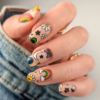“Nail” in Spanish: A Guide to Nail Terminology
Are you interested in learning about the word “nail” in Spanish and its various meanings in the context of nails, both for construction and personal grooming? In this article, we’ll explore the diverse ways “nail” can be expressed in the Spanish language, as well as related terminology and phrases.
1. The Basic Translation: “Clavo”
In Spanish, the most straightforward translation for “nail” is “clavo.” This term refers to the small, pointed metal fasteners commonly used in construction, carpentry, and various DIY projects. When you’re discussing nails in the context of construction or fixing things, “clavo” is the word you’ll often use.
2. Types of Nails in Spanish
Just as in English, there are different types of nails in Spanish. Here are a few common ones:
- Clavo de acero: Steel nail
- Clavo de madera: Wood nail
- Clavo de techo: Roofing nail
These variations specify the type of nail you’re referring to based on its material or purpose.
3. Nails for Personal Grooming: “Uña”
When discussing nails in the context of personal grooming, such as fingernails or toenails, the word “uña” is used. For example:
- Pintar las uñas: To paint nails (usually referring to fingernails)
- Cuidado de las uñas: Nail care
4. Nail Salon: “Salón de Uñas”
If you’re looking to visit a nail salon in a Spanish-speaking area, you’ll want to ask for a “salón de uñas.” These salons offer a variety of services, including manicures, pedicures, and nail art.
5. Common Phrases with “Nail”
In Spanish, just as in English, there are common phrases and idioms related to nails:
- Martillar un clavo: To hammer a nail
- Buscarle tres pies al gato: To look for trouble (literally, “to look for three feet on the cat,” referencing the difficulty of finding something that doesn’t exist)
- Dar en el clavo: To hit the nail on the head (meaning to be exactly right)
These phrases incorporate the concept of nails in various figurative ways.

6. Nail Art: “Arte de Uñas”
Nail art has gained popularity worldwide, and Spanish-speaking communities are no exception. If you’re interested in nail art services, you can inquire about “arte de uñas” at a nail salon. Nail artists create intricate and creative designs on your nails using various techniques and tools.
7. DIY Nail Care: “Cuidado de Uñas”
Maintaining healthy nails is important for personal grooming. You can learn about “cuidado de uñas” or nail care routines, including tips for keeping your nails strong and looking their best.
8. Cultural Insights
In Spanish-speaking cultures, nail care is an essential part of personal grooming, and many individuals take great pride in the appearance of their nails. Nail salons are commonly frequented for various services, and nail art is a popular way to express individual style.
The word “nail” in Spanish can refer to both construction fasteners (“clavo”) and fingernails/toenails (“uña”). Understanding these terms and phrases related to nails in Spanish will help you navigate discussions about DIY projects, personal grooming, and cultural practices in Spanish-speaking communities. Whether you’re hammering a “clavo” into wood or indulging in some “arte de uñas,” knowing the appropriate terminology is key to effective communication.


